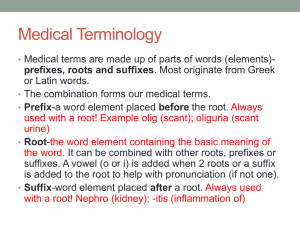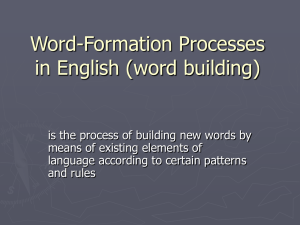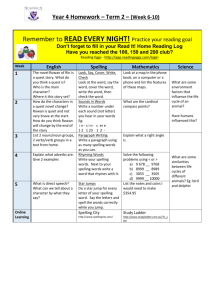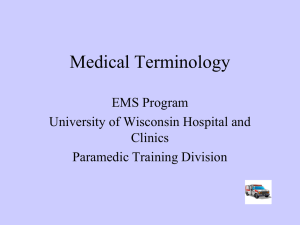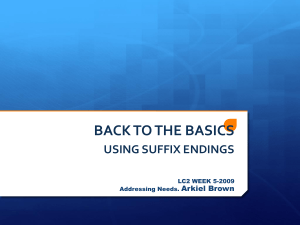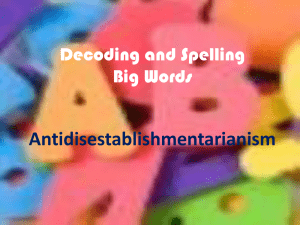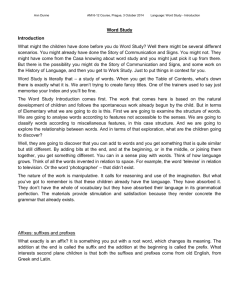Year 4 Homework T2 wk 1-5
advertisement
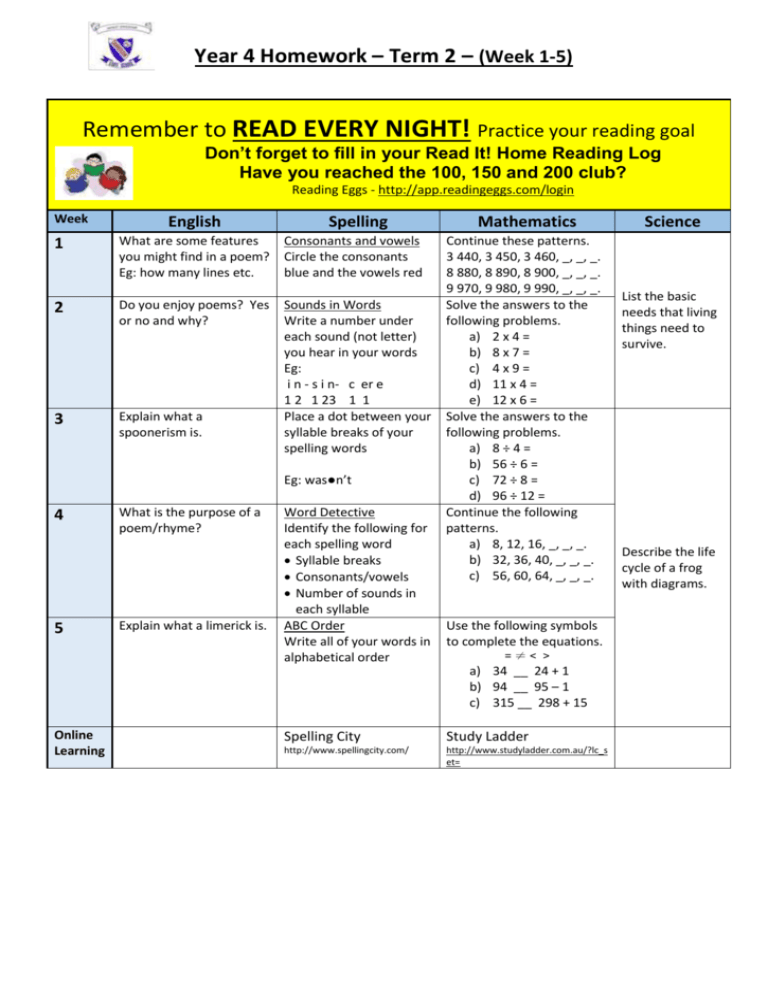
Year 4 Homework – Term 2 – (Week 1-5) Remember to READ EVERY NIGHT! Practice your reading goal Don’t forget to fill in your Read It! Home Reading Log Have you reached the 100, 150 and 200 club? Reading Eggs - http://app.readingeggs.com/login Week English Spelling 1 What are some features you might find in a poem? Eg: how many lines etc. Consonants and vowels Circle the consonants blue and the vowels red 2 Do you enjoy poems? Yes or no and why? 3 Explain what a spoonerism is. Sounds in Words Write a number under each sound (not letter) you hear in your words Eg: i n - s i n- c er e 1 2 1 23 1 1 Place a dot between your syllable breaks of your spelling words Eg: was●n’t 4 5 What is the purpose of a poem/rhyme? Explain what a limerick is. Word Detective Identify the following for each spelling word Syllable breaks Consonants/vowels Number of sounds in each syllable ABC Order Write all of your words in alphabetical order Mathematics Continue these patterns. 3 440, 3 450, 3 460, _, _, _. 8 880, 8 890, 8 900, _, _, _. 9 970, 9 980, 9 990, _, _, _. Solve the answers to the following problems. a) 2 x 4 = b) 8 x 7 = c) 4 x 9 = d) 11 x 4 = e) 12 x 6 = Solve the answers to the following problems. a) 8 ÷ 4 = b) 56 ÷ 6 = c) 72 ÷ 8 = d) 96 ÷ 12 = Continue the following patterns. a) 8, 12, 16, _, _, _. b) 32, 36, 40, _, _, _. c) 56, 60, 64, _, _, _. Use the following symbols to complete the equations. =≠< > a) 34 __ 24 + 1 b) 94 __ 95 – 1 c) 315 __ 298 + 15 Online Learning Spelling City Study Ladder http://www.spellingcity.com/ http://www.studyladder.com.au/?lc_s et= Science List the basic needs that living things need to survive. Describe the life cycle of a frog with diagrams. Group 4 Derivational relations - Harder suffixes Term 2 Weeks 1-10 Facilitator ____________________ Chapter II: Derivational suffixes I can use words with suffixes Sort 11 - Suffixes –al, -ial, -ic Chapter II: Derivational suffixes I can use words with suffixes Sort 12 - Adjective suffixes –ful, ous, ious Chapter II: Derivational suffixes I can use words with suffixes Sort 13 - Verb suffixes Chapter III: Suffix –ion I can use words with the suffix -ion Sort 14 - Adding –ion to the base word, to make a noun Chapter III: Suffix –ion I can use words with the suffix -ion Sort 15 - Suffixes --ion, ian fictional comical accidental arrival logical betrayal arrival logical betrayal musical global coastal delightful successful wasteful stressful wonderful shameful boastful cheerful beautiful dangerous humorous mountainous poisonous vigorous famous scandalous collection protection subtraction selection connection construction expression discussion oppression possession confession impression invention digestion desertion suggestion adoption insertion distortion prevention magician musician electrician clinician frighten straighten dampen sweeten dampen sweeten lengthen forbidden mistaken capitalise civilise symbolise idolise visualise energise harmonise burial territorial industrial tutorial memorial editorial magnetic poetic Islamic alphabetic heroic patriotic rhythmic angelic dramatic Focus Rules -al, -ial, -ic signal adjectives derived from nouns OR nouns derived from verbs -al, -ial, -ic – associated with or relating to WORD STUDY check dictionary for each base word create own meanings construct lists of other words– refer to additional words in Derivational Relations text Affixes – refer to previously taught prefix/suffixes Plurals S is usually used to make words plural ‘es’ is used for words ending with s, ss, x, sh ch & tch Tense verbs Add ‘ed’ & ‘ing’ suffix collect protect subtract select connect construct express discuss oppress possess confess impress Focus Rules -ful, -ous, -ious – ‘full of’ or ‘having qualities of’ Drop y before adding –ious Do not drop e when adding suffix beginning with a consonant ‘ful’ Change y to i ‘Full’, written alone, has two l’s, but when added as a suffix, only one l is written WORD STUDY check dictionary for each base word create own meanings construct lists of other words– refer to additional words in Derivational Relations text Affixes – refer to previously taught prefix/suffixes Plurals S is usually used to make words plural ‘es’ is used for words ending with s, ss, x, sh ch & tch Tense verbs Add ‘ed’ & ‘ing’ suffix invent digest desert suggest adopt insert distort prevent magic music electric clinic Focus Rules -en, -ise, -ify – to be or to cause to be’ creates verbs but sometimes adjectives en- is also a prefix & has a similar effect Change y to i E drop -ize – is the American spelling, like –or instead of -our WORD STUDY check dictionary for each base word create own meanings construct lists of other words– refer to additional words in Derivational Relations text Affixes – refer to previously taught prefix/suffixes Plurals S is usually used to make words plural ‘es’ is used for words ending with s, ss, x, sh ch & tch Tense verbs Add ‘ed’ & ‘ing’ suffix envious studious glorious rebellious furious outrageous Focus Rules Base words that end in two consonants generally add -ion -ct blend rarely used in one syllable words hard /k/ sound in –ct comes apart when /shun/ is added -ject -tract -struct -duct WORD STUDY check dictionary for each base word create own meanings construct lists of other words–refer to additional words in Derivational Relations text Affixes – refer to previously taught prefix/suffixes Plurals S is usually used to make words plural ‘es’ is used for words ending with s, ss, x, sh ch & tch Tense verbs Add ‘ed’ & ‘ing’ suffix memorise summarise apologise classify diversify falsify beautify simplify purify analyse Focus Rules word endings in –ct or -ss t sound changes when adding –ion s sound changes to /sh/ when adding -ion -ian – relating to, belonging to, resembling -ian is added to words ending with -ic WORD STUDY check dictionary for each base word create own meanings construct lists of other words–refer to additional words in Derivational Relations text Affixes – refer to previously taught prefix/suffixes Plurals S is usually used to make words plural ‘es’ is used for words ending with s, ss, x, sh ch & tch Tense verbs Add ‘ed’ & ‘ing’ suffix
